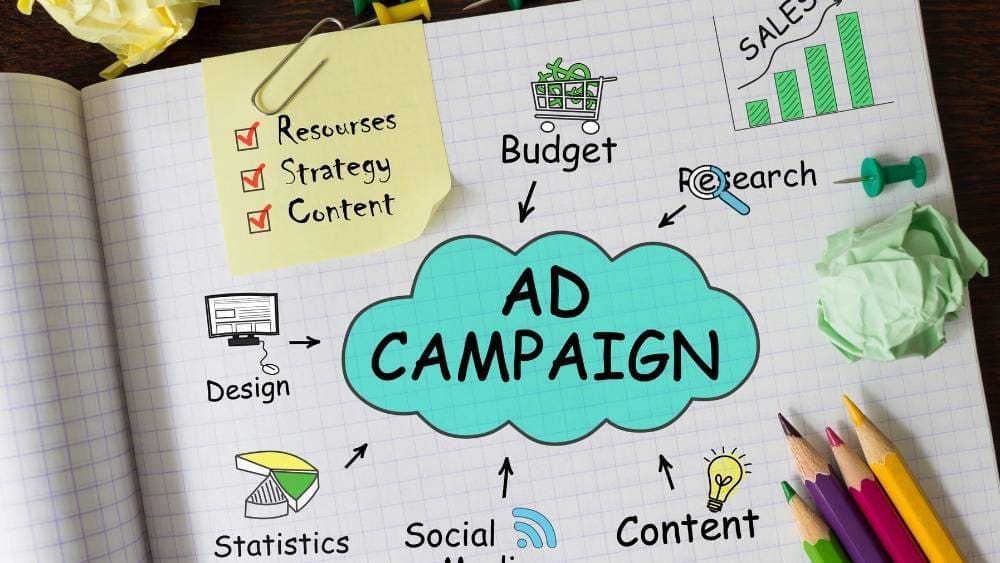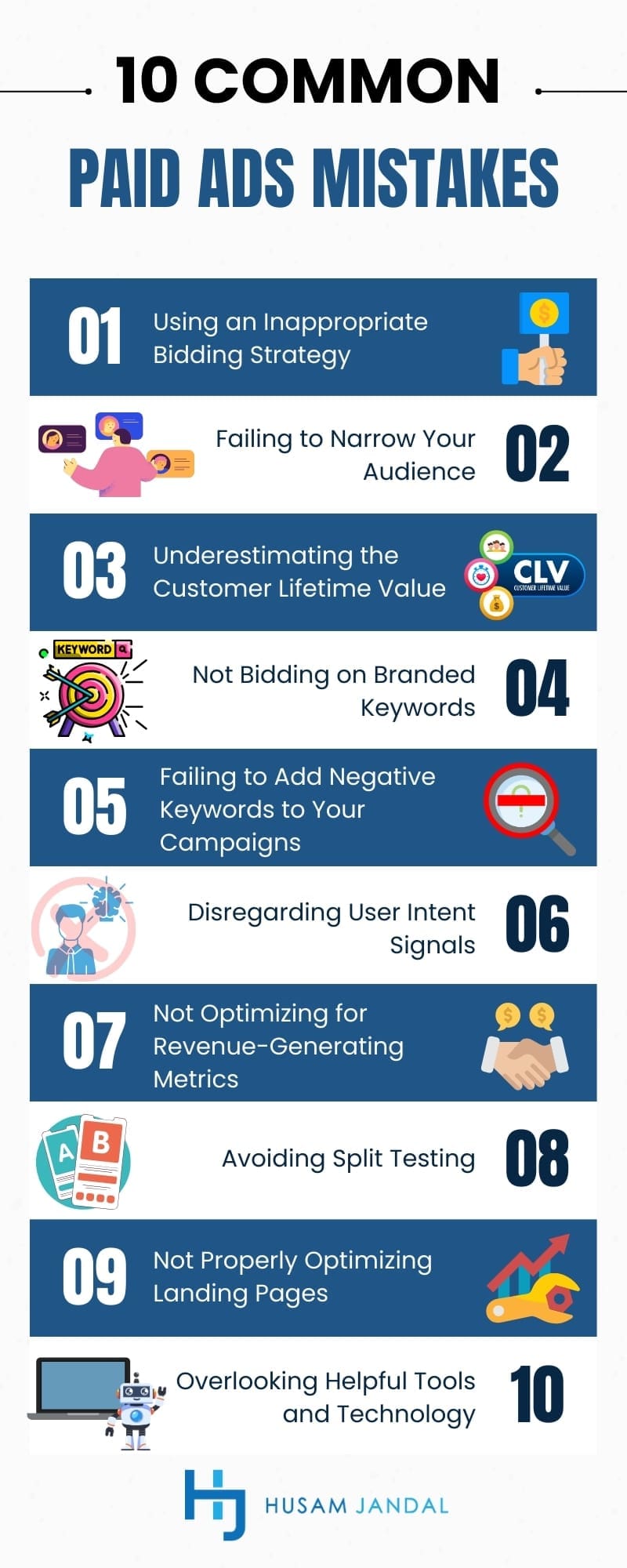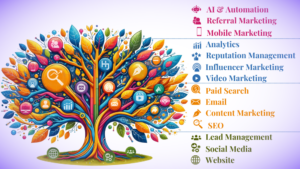 Are paid ad mistakes eating away at your budget and costing your business valuable sales leads? If you haven’t been formally trained in PPC management, the answer is “probably.” I previously worked as an educator for Google Partners, teaching digital marketing agencies how to set up and optimize their campaigns, and even the so-called “experts” don’t always get things right.
Are paid ad mistakes eating away at your budget and costing your business valuable sales leads? If you haven’t been formally trained in PPC management, the answer is “probably.” I previously worked as an educator for Google Partners, teaching digital marketing agencies how to set up and optimize their campaigns, and even the so-called “experts” don’t always get things right.
Not to worry. Between my work as an educator and the businesses I’ve helped as a digital marketing consultant, I’ve noticed some trends in people’s PPC mistakes. I’ll walk you through the most common ones and how to fix them on this page.
What’s Considered a “Paid Ad?”
Digital advertising is full of unique terms and acronyms. Before we dig into fixing paid ad mistakes, let’s get on the same page as to what a paid ad really is and some of the types of paid ads you’ll encounter.
Types of Digital Marketing Media
Digital marketing is usually broken down into three media categories: owned media, earned media, and paid media.
- Owned Media: Content that you create and publish on your own channels, such as your website or social media profiles.
- Earned Media Content someone else created about your business that you didn’t pay for, such as social shares or reviews.
- Paid Media: Content that you pay to promote, such as sponsored content, influencer marketing, and paid ads.
As you can see, businesses pay for press within the paid media bracket in many ways. However, paid ads are only one way.
Types of Paid Ad Models
There’s a similar breakdown within the paid ads bracket.
- Cost-Per-Click (CPC) Ads: The advertiser pays each time someone clicks on their ad. This is the measurement used in pay-per-click (PPC) marketing campaigns, so most people simply refer to CPC ads as PPC ads.
- Cost -Per-Mili (CPM) Ads: The advertiser pays for blocks of 1,000 impressions. An “impression” is logged each time an ad is displayed.
- Cost-Per-Acquisition (CPA) Ads: The advertiser only pays when someone takes a specific action after clicking the ad, such as purchasing something or requesting a demo.
The only CPA ads routinely seen today are affiliate marketing ads. CPC and CPM ad models are used more often. The lines between these two are murky because most platforms that allow advertisers to bid for ad placement on a CPC basis also allow them to do so on a CPM basis. The technical setup is often identical too. With that in mind, people often use the terms CPC, PPC, and CPM interchangeably, even though they’re technically different things.
Types of PPC and CPM Ads
Because PPC and CPM paid ads often work identically on the back end despite using a different measurement, this page will focus more on them as opposed to affiliate marketing campaigns.
Paid Search
If you want to get listed at the top of Google, Bing, and other search engines before your business ranks organically, you’ll use paid search ads.
Display Ads
If your brand wants to display graphical or video ads on third-party websites, you’ll use display ads. Google Ads and Microsoft Advertising have extensive ad networks, though there are many other platforms.
Social Media Ads
If you want to reach your audience on social media platforms such as Facebook, Twitter, and LinkedIn, there are two main ways to do so: display ads and boosted or sponsored posts.
Remarketing Ads
If you want to continue nurturing someone who visited your digital property but hasn’t officially become a lead yet or hasn’t purchased, you can use retargeting ads. This is a multi-pronged approach in which a pixel is placed in the visitor’s browser when they visit your site. When they visit another property that recognizes the pixel later, your ad may be displayed. Each ad platform has its own remarketing setup. For instance, Google offers it, as does Facebook.
Instream Ads
If your audience watches YouTube and your business creates videos for marketing, you can use instream ads. These are the ad videos that launch while you’re already watching a video, similar to the way TV commercials work.
Benefits of Running Pay-Per-Click Campaigns
- Fast Results: You can start generating PPC leads and sales as soon as your ads go live, whereas SEO can take months to produce results.
- Diversification: Your PPC strategy can help ensure you still get sales and leads even if search engine algorithm shifts impact your organic traffic.
- Improved Conversions: People who click on PPC ads are 50 percent more likely to purchase than those who come through organic search, according to Small Biz Genius research.
- Targeting: Your PPC campaign can target very specific groups of people, so your budget goes further, and your sales team produces better results.
- Data: Information you learn about prospects and their behavior can be used to guide your other digital marketing initiatives.
- Testing: Whether you’re focused on sales or lead generation, PPC ads can provide you with the traffic and opportunity to experiment with different A/B tests and ideas.
- High ROI/ ROAS: Google search, for example, returns an average of $2 for every $1 spent, per Small Biz Genius. In the ad world, return on investment (ROI) is referred to as return on ad spend (ROAS).
10 Common Paid Ads Mistakes & How to Fix Them to Boost PPC Leads
Now that we’ve covered the basics, let’s look at some of the most common paid ad mistakes and what you can do to avoid them or correct your paid ad strategy if they already apply to you.
1. Using an Inappropriate Bidding Strategy
Modern ad platforms use a bidding system to determine which ads to show. Most will automatically shift your bid based on your set criteria. However, one of the first PPC mistakes people make when setting up a campaign is failing to consider the ultimate goal. Not every campaign should be about conversions; even if conversions are your goal, you may not be ready to focus on those yet. Let’s take a quick look at the three main reasons businesses run ads and the types of bidding strategies that might be appropriate for each situation.
Focus on Views to Gain Visibility
Let’s say you’re presently focusing on the top of the sales funnel and just want people to recognize your brand exists. Or, maybe you’ve noticed that companies that resell your products or services are appearing before you in searches for your branded terms. You’re probably going to want to work with one of the following:
- Target Impression Share
- CPM
- tCPM
- vCPM
Focus on Clicks to Generate Website Traffic
If your primary goal is just to get people to your website, perhaps to read a blog or whitepaper, then a basic CPC bidding strategy will do.
Focus on Conversions to Get Visitors to Take a Specific Action
Let’s say you’re trying to get people to do something specific, like request a consultation, download a free trial, or purchase something. You have conversion tracking set up, and your account likely has some history that shows people taking these actions on your site. One of the following conversion-based strategies is likely to be ideal:
- Target Cost Per Action (CPA)
- Target Return on Ad Spend (ROAS)
- Maximize Conversions
- Maximize Conversions
- Enhanced cost per click (ECPC)
2. Failing to Narrow Your Audience
Not everyone is a good candidate for your products or services, let alone at the right stage of the customer journey for the ad you’ve placed. You must target the right audience for each campaign, or you will waste your ad budget trying to sell to the wrong people. Some of this is very basic, like narrowing down the geographic location to ensure you’re not advertising to people on the other side of the globe if you only operate locally. Other forms of PPC targeting are more complex and require that you know your customer on a much deeper level. You’ll need the information contained in your buyer personas at a minimum, and possibly data from previous ad campaigns and/or your CRM.
3. Underestimating the Customer Lifetime Value
How much are you willing to pay for each view, click, or conversion? Often, people dabbling in PPC will come up with an arbitrary value here, such as no more than $1 or no more than $3. Those with a bit more experience will reflect on the figures on their Google Keyword Tool report, which features a high and low figure, then choose a number right in the middle. Unfortunately, neither of these approaches is right when you’re setting up a PPC ad campaign.
Instead, you must first understand your customer lifetime value (CLV). A simplified formula for this is the average annual revenue your business generates from a customer multiplied by the average number of years a customer stays with you. When you know this figure, it’s much easier to determine how much you can reasonably spend to acquire a new customer and still turn a profit.
Let’s say you run a small retail business selling only one item. It retails for $25 and costs you $5 to manufacture it, so you make a $20 profit, but each customer only buys it once. Your CLV is $20. Barring any unique circumstances, you could probably spend up to a little over $6 acquiring each customer. Bear in mind, this doesn’t mean you should set your maximum cost per click at $6. Not every person who clicks will convert.
Now, let’s instead say that you operate a business process outsourcing firm, and your typical client brings you $25,000 in revenue each year and stays with you for seven years. Your CLV is $175,000. Following the same formula, you could realistically spend around $58,000 acquiring each client. But, again, you’re not going to set your ad budget to allow for $58,000 clicks. Not everyone is going to convert.
Moreover, you’re going to have a longer, more intensive sales cycle. You will have to include the cost of demos, tours, collaborative sessions, and more in your acquisition costs. Needless to say, though, your CPC can be significantly higher in this situation than in the retail example given first. Don’t sell yourself short by setting your budget too low.
4. Not Bidding on Branded Keywords
As you may recall, we briefly touched on branded keywords when we covered bidding strategy issues. Branded keywords include things like your business name and products or services. Any trademarks or slogans your company uses would fall into this bracket too.
If you’re mastering your SEO, your website is going to display as the first organic search result when people search for these terms. As you know, however, paid ads appear before organic listings. That means people who resell your products or services can rank before you for your own terms. And, while most ad platforms will disqualify advertisers from mentioning your trademarks in their ads, they can still use your branded terms as keywords and outrank you. Another company might also slip your trademarks past an ad platform or use phrasing to mislead people into thinking they’re going to your website.
With that in mind, not bidding on your branded keywords could be one of your business’s biggest PPC mistakes. Remember, you can tailor your ad spend, so even if your business is so small that people don’t know who you are yet, your spend on this campaign is going to be very small too.
5. Failing to Add Negative Keywords to Your Campaigns
The word “keyword” is usually thought of as a word that you want to use in your digital marketing efforts. For instance, you use keywords on your website when optimizing for search engines. Then, you select keywords that trigger your ads to display when setting up a PPC campaign.
One of the most common mistakes in paid search advertising is not recognizing that you should also add negative keywords. These are words that will prevent your ads from showing.
Let’s say, for example, you’re an accountant in the business services sector. If you add the word “accounting” as a traditional keyword, your ads are going to display when people search for:
- Accounting Jobs
- Consumer Accounting
- Accounting Training
- DIY Accounting
- Accounting Apps
The list of things you don’t want your ads to display for could be extensive depending on how detailed your keyword list is, your industry, and the particulars of your business. Start with a robust negative keyword list and keep adding to it as you examine your ad reports. It’ll prevent your ads from displaying when they shouldn’t and preserve your budget for people more likely to be interested in your business.
6. Disregarding User Intent Signals

User intent, also known as “search intent,” “searcher intent,” and “keyword intent,” refers to the reason someone types a query into a search engine. There are four main types:
- Navigational Intent: The searcher wants to find a specific page. An example of this type of search might be “Contact Husam Jandal.” We can reasonably conclude that this person would be satisfied if they were directed to my contact page.
- Informational Intent: The searcher wants to learn more about something. For example, “What is UTM Tracking?” We can conclude this person would get what they needed if directed to my article on UTM tracking.
- Commercial Intent: The searcher wants to research before purchasing or retaining services. For example, someone searching for “finance industry digital marketing consultant” is likely in the finance industry and wants to hire a digital marketing consultant who specializes in their industry, but is still exploring all their options.
- Transactional Intent: The searcher wants to complete a specific action, such as retaining services or making a purchase. In this case, we might see something like “Husam Jandal consult.” We can conclude the person is ready to discuss their marketing concerns with me.
A multitude of PPC mistakes related to intent can occur. Consider, as an example, what happens when someone performs a search with informational intent and is shown a commercial intent ad? If they’re on autopilot and click the ad because it’s first, they’ll be sent to a conversion-oriented landing page with a lead gen form instead of the answer to their question. They’re going to bounce as soon as they realize where they are, and the cost to get them there is wasted. Intent must be considered at every level: keyword, ad copy, and landing page.
7. Not Optimizing for Revenue-Generating Metrics
Getting lost in paid advertising metrics is easy because so many things contribute to running a successful campaign. For instance, many people focus on their click-through rate (CTR) because it’s an indicator of whether their ad copy is performing. Of course, you should keep an eye on your CTR, but even if you’re mastering it, it doesn’t mean your ads are actually producing revenue for your business.
Depending on your overall business goals, optimize for one or more of the following revenue-focused KPIs:
- Cost Per Click (CPC)
- Cost Per Acquisition (CPA)
- Return on Ad Spend (ROAS)
8. Avoiding Split Testing
Newcomers to paid ads often have a set-it-and-forget-it mindset, especially if they start getting any results. That’s a huge mistake because, as we covered earlier, you must continuously add negative keywords to your account, campaigns, and ads to avoid wasted ad spend. Another area that needs regular attention is split testing. Instead of helping you avoid waste, it enables you to optimize so your campaigns get better results.
Split testing involves randomly assigning your audience into groups and serving them with different versions of your digital marketing assets. Most of the time, this is done as A/B testing, a type of split testing that only involves two variants. For example, with A/B testing, you might create the exact same display ad, but present it with two different images, change the CTA, or change the color of a CTA button to see which one gets more clicks. Through experimenting with A/B tests on landing pages alone, brands can achieve a five percent boost in conversions, WordStream research shows.
Many modern ad networks now force advertisers to take a similar approach when creating ads as well. For instance, Google has advertisers create responsive ads by providing multiple headlines and descriptions. The platform then chooses which portions to show and in which order based on what it thinks will be most effective given your goals and the person viewing the ad. As a result, early adopters of responsive search ads saw up to ten percent more clicks and conversions, Google reports.
9. Not Properly Optimizing Landing Pages
Another one of the big paid ad mistakes involves landing pages. These are standalone web pages that are designed specifically for a campaign. It’s where the person goes when they click on the ad.
The first issue I often see here is that some businesses don’t use landing pages at all. Instead, their ads link to their homepage or a generic website page. Research also suggests this is very common. For instance, more than 40 percent of B2B clicks go to the brand’s homepage, HubSpot research shows.
The second issue I often see is that if a landing page is in use, it’s not optimized to encourage visitors to do whatever they came to do. Here are some examples:
- Keyword: The landing page is generic and doesn’t relate to the person’s search query.
- Persona: The page doesn’t feel personalized or targets a different persona.
- Intent: The purpose of the page doesn’t align with the visitor’s stage in the customer journey or their search intent (navigational, informational, commercial, transactional).
- Consistency: There’s a disconnect between the messaging or branding of the ad and the landing page.
- Experience: There are issues with the user experience (UX), such as slow loads or lack of mobile-friendliness.
- Conversions: The page isn’t set up in a way that builds trust and moves the person toward the next step.
If visitors arrive on your landing page and then bounce, you probably have an optimization issue. Conversely, brands that fall in the top quarter of advertisers have a conversion rate of 5.31 percent, WordStream data shows. Those that make it into the top 10 percent have an average conversion rate of 11.45 percent.
10. Overlooking Helpful Tools and Technology
The paid advertising landscape is constantly evolving. By taking advantage of some of the latest ad tech, your business may be able to gain new insights and improve your results.
Paid Ad Automation
Most advertising platforms provide automation tools. For instance, you can set your ads to run at certain times, automatically pause low-performing ads or keywords, and generate reports.
Programmatic Bidding
Programmatic bidding streamlines the ad buying process by allowing brands to automatically bid for ad placement when the reader is most likely to take the desired action. If, for example, you know that men aged 40-50 who like golf are more likely to buy your product or service, you can target them through a programmatic bidding strategy.
This approach works particularly well for B2C marketing because there’s usually only one person involved in the decision-making process and the sale is often instant. B2B brands, on the other hand, are unlikely to have the same degree of success because many people are likely involved and the cycle may be measured in weeks or months rather than days. Even still, some insights may be gained by experimenting and testing different audiences.
Artificial Intelligence
Artificial intelligence is constantly evolving and being used for maximizing marketing results. For instance, some AI platforms will link together and monitor all your platforms at once, then automatically shift your budgets to the channels and ads that work best.
Get Help Increasing Your PPC Effectiveness and Boosting Leads
As a digital marketing consultant, I help businesses strengthen their PPC strategies daily. Whether you’re making one of these common paid ad mistakes and need help fixing it or aren’t reaching your lead generation goals and aren’t sure why, I’m happy to help. Contact me for a complimentary consultation.





































































